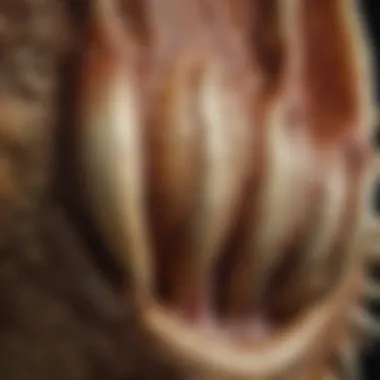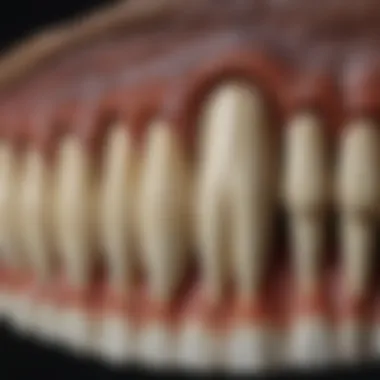Unveiling the Enigmatic World of Triceratops Teeth: A Paleontological Exploration


Rock and Fossil Identification
Triceratops teeth offer a fascinating window into the prehistoric world, showcasing unique features that captivate rock and fossil collectors. In paleontological studies, understanding the types of rocks and fossils where these teeth are found is crucial. Fossilized remains of Triceratops teeth are often embedded in sedimentary rocks, such as sandstone or shale, characterized by distinct layers that reveal a timeline of geological processes. When identifying these fossils, collectors should look for well-defined dental ridges and enamel patterns unique to Triceratops, distinguishing them from other dinosaur species. Tools such as geological hammers and chisels are essential for carefully extracting and examining these delicate specimens.
Collecting Tips and Techniques
For enthusiasts seeking to add Triceratops teeth to their collections, adopting best practices for collecting is paramount. Locating prime sites where these fossils are prevalent, such as sedimentary rock formations in regions known for dinosaur discoveries, increases the likelihood of success. When extracting Triceratops teeth, collectors should exercise caution to avoid damaging the fragile structures. Techniques like using a fine brush to remove excess debris or stabilizing the surrounding rock matrix are effective in ensuring the integrity of the specimen.
Preservation and Display
Preserving Triceratops teeth entails meticulous care to maintain their authenticity and structural integrity. Techniques such as applying consolidants to strengthen fragile sections or using protective coatings to prevent degradation are common practices. Proper storage methods, such as storing fossils in a controlled environment with stable temperature and humidity levels, help prevent deterioration over time. Creative display ideas, like mounting individual teeth in transparent cases to showcase their intricate details, engage collectors and educational enthusiasts alike.
Geological Insights
Tracing the geological origins of Triceratops teeth offers valuable insights into the history of these majestic creatures. Rocks and fossils that preserve these dental remains provide clues to the environmental conditions and habitats where Triceratops thrived. Paleontologists study the geological formations and processes that shaped these landscapes, unraveling the historical significance of fossilized teeth in reconstructing past ecosystems. Notable discoveries, like finding well-preserved teeth in association with identifiable rock layers, contribute to our understanding of Triceratops' behavior and evolution.
Introduction to Triceratops Teeth
In this section, we delve into the captivating world of Triceratops teeth, exploring their unique features, functions, and significance in paleontological studies. Triceratops teeth are a crucial aspect of understanding the behavior and ecology of this iconic dinosaur, offering valuable insights into its dietary habits and feeding mechanisms. By examining these prehistoric dental structures, researchers can unravel the mysteries of how Triceratops interacted with its environment and the evolutionary adaptations that shaped its existence.
An Overview of Triceratops
The Evolution of Triceratops
The evolution of Triceratops is a significant aspect of this article as it sheds light on the development and adaptation of this fascinating dinosaur over time. Understanding the evolutionary history of Triceratops allows researchers to trace its lineage and determine how it evolved to become one of the most recognizable dinosaurs in history. By studying the evolutionary trends of Triceratops, scientists can glean valuable information about its genetic diversity, morphological changes, and environmental influences that shaped its evolution.


Distinctive Physical Characteristics
Triceratops is known for its distinct physical features, most notably its three horns and elaborate frill. These unique characteristics set Triceratops apart from other dinosaurs of its time and serve as key identifiers of this species. The horns and frill of Triceratops played integral roles in its survival and interaction with its surroundings, making it a subject of fascination for paleontologists seeking to understand the functional significance of these prominent features.
Importance of Studying Triceratops Teeth
Insights into Dietary Habits
Studying Triceratops teeth provides valuable insights into the dietary habits of this dinosaur, offering clues about its preferred food sources, chewing mechanisms, and digestion processes. By analyzing the wear patterns and dental morphology of Triceratops teeth, researchers can infer details about its diet composition, feeding strategies, and niche specialization within its ecosystem. Understanding the dietary habits of Triceratops is essential for reconstructing its paleoecology and comprehensively interpreting its role in the Late Cretaceous food web.
Behavioral Interpretations
Examining Triceratops teeth also aids in deciphering the behavioral patterns and social interactions of this dinosaur. The study of tooth marks, tooth shape variations, and tooth replacement patterns can reveal information about Triceratops' social structure, mating behaviors, and territoriality. By investigating the behavioral implications of Triceratops teeth, researchers can construct a more holistic understanding of its behavioral ecology and infer how these behaviors contributed to its evolutionary success.
Structural Composition of Triceratops Teeth
Triceratops teeth hold a crucial place in paleontological studies, making the exploration of their structural composition a vital component of this article. Understanding the composition of these teeth provides invaluable insights into the evolutionary adaptations and dietary habits of the iconic Triceratops. By examining the types of teeth present in Triceratops and delving into the dental microstructure, we can unravel the mysteries surrounding the life of this dinosaur through its dental remnants, offering a holistic view of its existence.
Types of Teeth Present in Triceratops
Incisiform teeth
Incisiform teeth in Triceratops play a significant role in its feeding mechanisms and overall dental functionality. These specialized teeth are essential for cutting and shearing vegetation, reflecting the herbivorous diet of Triceratops. The unique morphology of incisiform teeth provides efficient processing of plant material, showcasing the evolutionary adaptations that facilitated the dinosaur's consumption of fibrous plants. Their particular shape and structure contribute to the success of Triceratops as a dominant herbivore during the Late Cretaceous period.
Molariform teeth


On the other hand, molariform teeth serve a different function in Triceratops' dental structure. These teeth are critical for grinding and pulverizing tough plant matter, enabling the dinosaur to extract nutrients effectively from a variety of vegetation. The robust nature of molariform teeth highlights their durability and wear-resistant properties, showcasing their adaptability to the challenging diet of Triceratops. Their distinct shape and arrangement indicate specialized dental evolution tailored to the specific dietary requirements of this iconic dinosaur.
Dental Microstructure
Dentine composition
The dentine composition of Triceratops teeth offers essential insights into their structural integrity and functional capabilities. Dentine, a core component of teeth, provides support and strength to withstand the forces exerted during feeding activities. The unique composition of dentine in Triceratops reflects adaptations to a herbivorous diet, enhancing the efficiency of food processing and nutrient extraction. Understanding the dentine composition elucidates the mechanical properties that enabled Triceratops to thrive in its ecosystem, shedding light on its dental evolution and dietary preferences.
Enamel structure
The enamel structure of Triceratops teeth contributes significantly to their protective covering and resistance to wear. Enamel, the outer layer of teeth, acts as a barrier against abrasion and chemical damage, preserving the underlying dentine. The intricate structure of enamel in Triceratops reflects functional adaptations to a rough plant-based diet, emphasizing the durability and longevity of these dental structures. Exploring the enamel structure provides valuable information on the dietary habits and ecological niche of Triceratops, highlighting the intricate interplay between form and function in its dental evolution.
Functionality of Triceratops Teeth
Triceratops teeth are crucial components in understanding the dietary habits and behavior of this iconic dinosaur species. The functionality of Triceratops teeth serves as a window into its feeding mechanisms, offering insights into how it processed vegetation and sustained its massive size. By examining the structure and wear patterns of Triceratops teeth, paleontologists can decipher the chewing mechanics employed by these creatures. Understanding the functionality of their teeth allows researchers to reconstruct the feeding behaviors of Triceratops and infer their adaptations to a herbivorous diet. Furthermore, the study of Triceratops teeth provides essential clues about the ecosystem in which they lived and the evolutionary pressures that shaped their dental morphology.
Chewing Mechanisms
Grinding capabilities
Grinding capabilities of Triceratops teeth play a pivotal role in the processing of tough plant material. The distinct shape and arrangement of their teeth facilitated efficient grinding, breaking down fibrous vegetation into digestible particles. This feature enabled Triceratops to extract maximum nutrients from its food sources, supporting its energetically demanding herbivorous lifestyle. The well-developed grinding capabilities of Triceratops teeth signify their specialization for processing tough plant matter, showcasing an evolutionary adaptation that allowed these dinosaurs to thrive in their ecological niche.
Food processing strategies
Triceratops employed sophisticated food processing strategies to optimize nutrient extraction from vegetation. Their teeth were adept at shearing tough plant material and generating pulpy mixes that could be easily digested. This strategy of pre-processing food before ingestion enhanced the efficiency of nutrient absorption, enabling Triceratops to meet its metabolic requirements. By employing these food processing strategies, Triceratops demonstrated an evolutionary advantage in efficiently utilizing the resources available in its environment, highlighting the remarkable adaptability of these ancient herbivores.


Feeding Behavior
Herbivorous diet adaptations
The herbivorous diet adaptations of Triceratops teeth are reflective of their specialized feeding behavior. These adaptations include features such as dental batteries for continuous chewing and replacement of worn teeth to maintain optimal functionality. Triceratops evolved efficient herbivorous dentition that allowed for the breakdown of abrasive plant material, showcasing their adaptation to a plant-based diet. The remarkable adaptations in their dentition are indicative of the selective pressures exerted by their environment, emphasizing the evolutionary success of Triceratops in navigating the challenges of herbivory.
Strategies for consuming vegetation
Triceratops developed specific strategies for efficiently consuming vegetation, incorporating behaviors such as selective feeding on nutrient-rich plants and employing varying tooth functions for different food types. These strategies enabled Triceratops to diversify its diet and adapt to seasonal changes in vegetation availability. By employing versatile strategies for consuming vegetation, Triceratops showcased its adaptive prowess in maximizing nutrient intake from a wide range of plant sources, underscoring the sophisticated dietary behaviors exhibited by these dinosaurs.
Paleontological Significance of Triceratops Teeth
In the realm of paleontology, the study of Triceratops teeth holds paramount importance in unraveling the mysteries of this iconic dinosaur species. The dental remains of Triceratops provide invaluable insights into various aspects of their biology, behavior, and ecological interactions. By meticulously examining the structure, composition, and function of these teeth, researchers can piece together the dietary preferences, feeding patterns, and evolutionary adaptations of Triceratops with remarkable accuracy. This section delves deep into the significant role that Triceratops teeth play in shaping our understanding of prehistoric ecosystems and the adaptation strategies of ancient herbivorous creatures.
Fossil Discoveries
Identification of Triceratops Specimens
The process of identifying Triceratops specimens is a meticulous endeavor that involves scrutinizing various anatomical features and unique characteristics specific to this dinosaur species. By focusing on distinguishing traits such as the shape, size, and arrangement of teeth, paleontologists can differentiate between different Triceratops individuals and even identify potential subspecies or variants within the genus. This detailed examination of dental remains not only helps in cataloging fossil specimens but also aids in tracing the evolutionary lineage and geographic distribution of Triceratops populations over time. The identification of Triceratops specimens serves as a cornerstone in paleontological research, offering a wealth of data for understanding the diversity and anatomical variations present within this fascinating dinosaur group.
Analysis of Dental Remains
Analyzing the dental remains of Triceratops sheds light on a myriad of aspects related to its feeding behavior, dental health, and ecological niche. By studying the wear patterns, enamel structure, and occlusal surfaces of Triceratops teeth, scientists can infer crucial information regarding their dietary habits, food processing strategies, and overall oral health. This detailed analysis not only provides clues about the types of vegetation consumed by Triceratops but also reveals behavioral adaptations and evolutionary trends related to dental morphology and functionality. By closely examining the dental remains of Triceratops, researchers can unravel the complex interplay between diet, environment, and evolution in shaping the ecological dynamics of this prehistoric herbivore.
Research Implications
Insights into Triceratops Ecology
Exploring the ecological aspects of Triceratops based on dental evidence offers profound insights into the feeding ecology, habitat preferences, and population dynamics of this magnificent dinosaur. By deciphering the isotopic signatures, microwear patterns, and dental morphology of Triceratops teeth, scientists can reconstruct detailed scenarios of how these giant herbivores interacted with their environment, processed food resources, and coexisted with other species. This in-depth exploration of Triceratops ecology not only enhances our understanding of ancient ecosystems but also provides a framework for assessing the responses of large herbivorous dinosaurs to environmental changes and resource availability.
Evidence of Evolutionary Adaptations
The dental record of Triceratops serves as a testament to the evolutionary adaptations and anatomical innovations that shaped the survival strategies of this dinosaur species over millions of years. By analyzing the changes in tooth morphology, enamel thickness, and dental microwear patterns across different Triceratops specimens, researchers can discern the evolutionary pressures that drove the diversification and specialization of these herbivorous dinosaurs. The presence of distinct dental features such as dental batteries, self-sharpening mechanisms, and complex dental occlusion patterns provides concrete evidence of the adaptive responses of Triceratops to varying dietary requirements and ecological niches. Unraveling the evidence of evolutionary adaptations in Triceratops teeth illuminates the remarkable evolutionary journey undertaken by these charismatic dinosaurs and enhances our appreciation for their resilience and success in ancient ecosystems.







